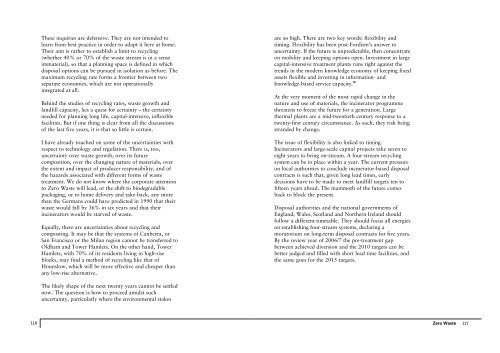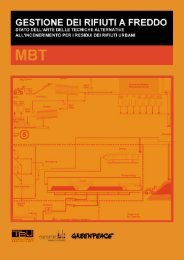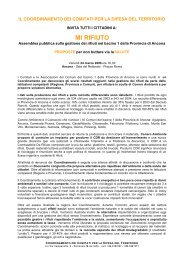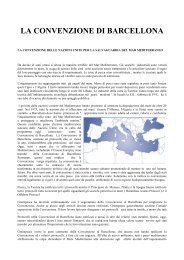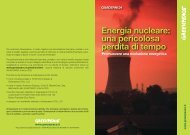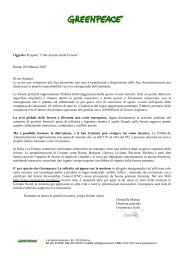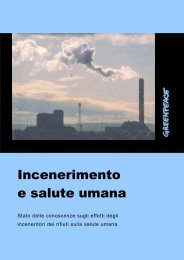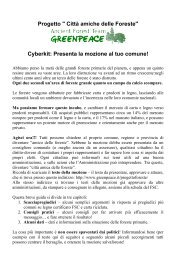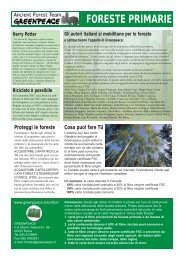Zero Waste by Robin Murray, Greenpeace Environmental Trust 2002
Zero Waste by Robin Murray, Greenpeace Environmental Trust 2002
Zero Waste by Robin Murray, Greenpeace Environmental Trust 2002
Create successful ePaper yourself
Turn your PDF publications into a flip-book with our unique Google optimized e-Paper software.
These inquiries are defensive. They are not intended to<br />
learn from best practice in order to adapt it here at home.<br />
Their aim is rather to establish a limit to recycling<br />
(whether 40% or 70% of the waste stream is in a sense<br />
immaterial), so that a planning space is defined in which<br />
disposal options can be pursued in isolation as before. The<br />
maximum recycling rate forms a frontier between two<br />
separate economies, which are not operationally<br />
integrated at all.<br />
Behind the studies of recycling rates, waste growth and<br />
landfill capacity, lies a quest for certainty – the certainty<br />
needed for planning long life, capital-intensive, inflexible<br />
facilities. But if one thing is clear from all the discussions<br />
of the last five years, it is that so little is certain.<br />
I have already touched on some of the uncertainties with<br />
respect to technology and regulation. There is, too,<br />
uncertainty over waste growth, over its future<br />
composition, over the changing nature of materials, over<br />
the extent and impact of producer responsibility, and of<br />
the hazards associated with different forms of waste<br />
treatment. We do not know where the corporate attention<br />
to <strong>Zero</strong> <strong>Waste</strong> will lead, or the shift to biodegradable<br />
packaging, or to home delivery and take-back, any more<br />
than the Germans could have predicted in 1990 that their<br />
waste would fall <strong>by</strong> 36% in six years and that their<br />
incinerators would be starved of waste.<br />
Equally, there are uncertainties about recycling and<br />
composting. It may be that the systems of Canberra, or<br />
San Francisco or the Milan region cannot be transferred to<br />
Oldham and Tower Hamlets. On the other hand, Tower<br />
Hamlets, with 70% of its residents living in high-rise<br />
blocks, may find a method of recycling like that of<br />
Hounslow, which will be more effective and cheaper than<br />
any low-rise alternative.<br />
are so high. There are two key words: flexibility and<br />
timing. Flexibility has been post-Fordism’s answer to<br />
uncertainty. If the future is unpredictable, then concentrate<br />
on mobility and keeping options open. Investment in large<br />
capital-intensive treatment plants runs right against the<br />
trends in the modern knowledge economy of keeping fixed<br />
assets flexible and investing in information- and<br />
knowledge-based service capacity. 78<br />
At the very moment of the most rapid change in the<br />
nature and use of materials, the incinerator programme<br />
threatens to freeze the future for a generation. Large<br />
thermal plants are a mid-twentieth century response to a<br />
twenty-first century circumstance. As such, they risk being<br />
stranded <strong>by</strong> change.<br />
The issue of flexibility is also linked to timing.<br />
Incinerators and large-scale capital projects take seven to<br />
eight years to bring on-stream. A four-stream recycling<br />
system can be in place within a year. The current pressure<br />
on local authorities to conclude incinerator-based disposal<br />
contracts is such that, given long lead times, early<br />
decisions have to be made to meet landfill targets ten to<br />
fifteen years ahead. The mammoth of the future comes<br />
back to block the present.<br />
Disposal authorities and the national governments of<br />
England, Wales, Scotland and Northern Ireland should<br />
follow a different timetable. They should focus all energies<br />
on establishing four-stream systems, declaring a<br />
moratorium on long-term disposal contracts for five years.<br />
By the review year of 2006/7 the pre-treatment gap<br />
between achieved diversion and the 2010 targets can be<br />
better judged and filled with short lead time facilities, and<br />
the same goes for the 2015 targets.<br />
The likely shape of the next twenty years cannot be settled<br />
now. The question is how to proceed amidst such<br />
uncertainty, particularly where the environmental stakes<br />
116<br />
<strong>Zero</strong> <strong>Waste</strong><br />
117


